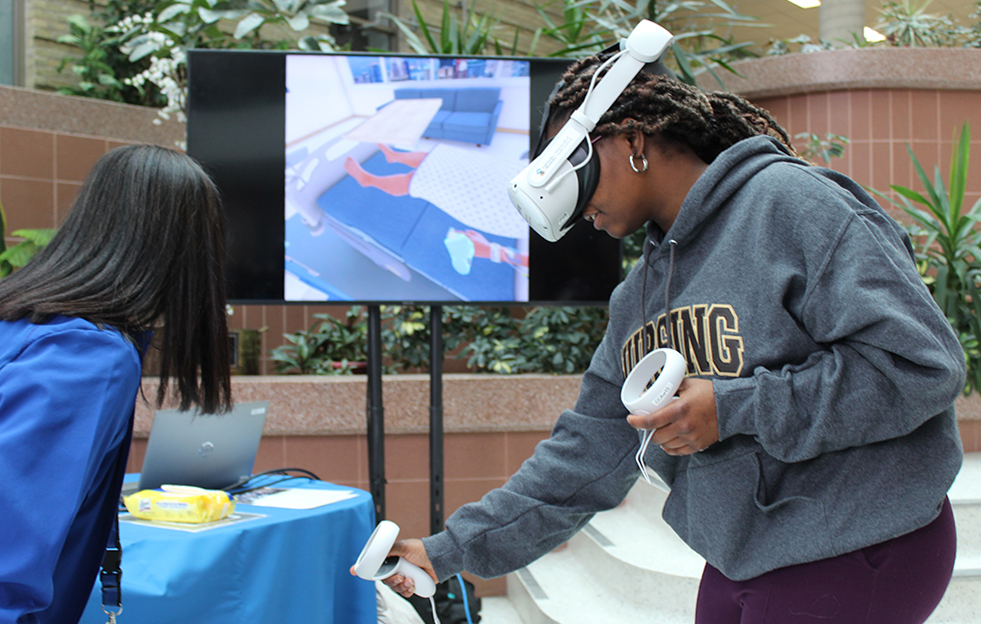
Busolami Olaide tries out a VR nursing simulation.
VR technology to build confidence and competence in health-care learners
On March 15, dozens of students, faculty and staff at the Rady Faculty of Health Sciences stood in the Brodie Atrium at Bannatyne campus and were transported to hospital rooms, care facilities and even accident sites by wearing virtual reality (VR) headsets.
Five stations were set up showing different VR, artificial intelligence (AI) and machine learning options available through RadyVerse, a new initiative that will expand the use of this technology across the faculty.
Dr. Nicole Harder, associate dean, undergraduate programs and professor in the College of Nursing, and Mindermar Professor in Human Simulation, Rady Faculty of Health Sciences, said the College of Nursing has been using VR in its bachelor of nursing program since Fall 2022, and other colleges have begun exploring its potential as a learning tool.
“VR is an immersive experience that can be extremely powerful for learning. In the College of Nursing, it is embedded into our curriculum. Building on our experiences, we discussed the opportunity to expand it to all the colleges in the Rady Faculty, and that is how the RadyVerse came to be,” Harder said.
Lanette Siragusa, vice-dean (education), Rady Faculty of Health Sciences, said she is eager to see how the technology will help students advance their skills as members of interprofessional health-care teams.
“Interprofessional collaboration is a key focus within the Rady Faculty of Health Sciences,” she said. “We know this positively impacts our patients’ and clients’ outcomes, and VR will only help our learners to advance these skills.”
Among the demonstrations was a VR scenario on discharge planning created by the Office of Interprofessional Collaboration (OIPC). The scenario was created with input from across the faculty’s five colleges and took about two weeks to produce. It involved a fictional patient who was admitted to hospital with an exacerbation of their chronic lung disease.
“They are going home with a new prescription for home oxygen, a walker and a variety of new medications, as well as oral health concerns,” said OIPC director and assistant professor of physical therapy Dr. Moni Fricke.
“Who will be responsible for teaching them how and when to use their home oxygen? Is it the respiratory therapist? The physician? The physiotherapist? The PA? Or the nurse? There’s a lot of overlap in our scopes of practice and roles in the health-care system. By using this sort of simulation and technology, learners can get the practice they need to clarify and negotiate their roles,” Fricke said.
Sandra Biesheuvel, a respiratory therapy (RT) instructor in the College of Rehabilitation Sciences, said her department has been looking into incorporating VR into its curriculum. After taking in the different simulations at the event, she said she has a better understanding of how different programs can be used.
“We’ve trialed VR a couple of times in the RT department already. But this one I just tried is an interprofessional simulation, so I could ask questions about the patient’s therapy, her cough, her inhalers – things that are really relevant to RT,” she said.
Busolami Olaide, who will be starting the bachelor of nursing program this summer, dropped by to get a better idea of the tools she’ll be using in the program. After trying one of the VR demonstrations, she said she could easily see how the technology could benefit students before they go into clinical placements.
“It will be helpful to develop communication skills in VR before seeing patients in real life, without messing up or potentially hurting anyone,” Olaide said.
Kevin Park, a second-year medical student in the Max Rady College of Medicine, tried out most of the technology on display, including generative AI software that allows learners to practice their communication skills by speaking to an avatar representing a patient or family member through a microphone.
“I spoke to it like a patient and it gave me responses. It took a little bit for it to register and respond, but I thought the responses seemed very realistic. It was pretty cool,” he said.
Park has never used VR before, but he can see it being easy to learn.
“I struggled with the headset a bit. There’s obviously a learning curve to it, but I think once you get used to it, it could be useful for sure.”
Watch a video and news coverage of the event on CTV, CBC and Global.






